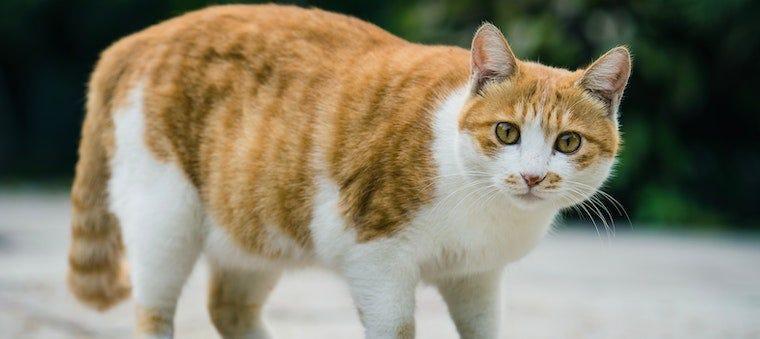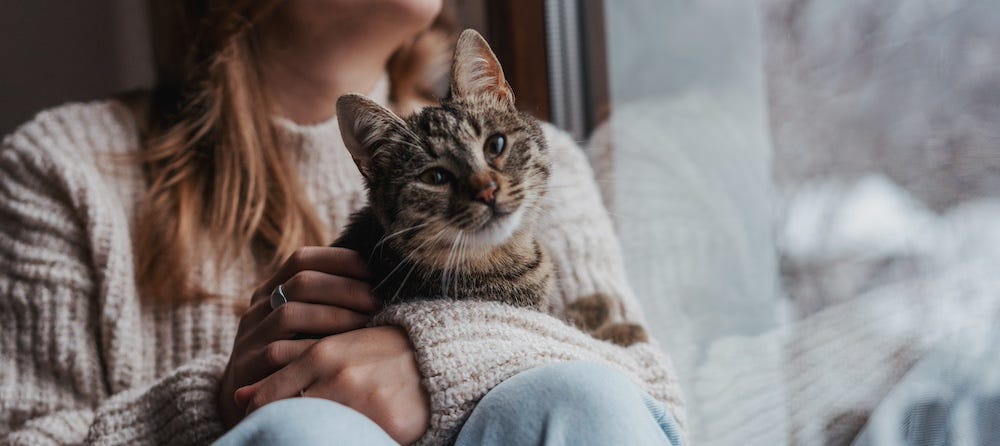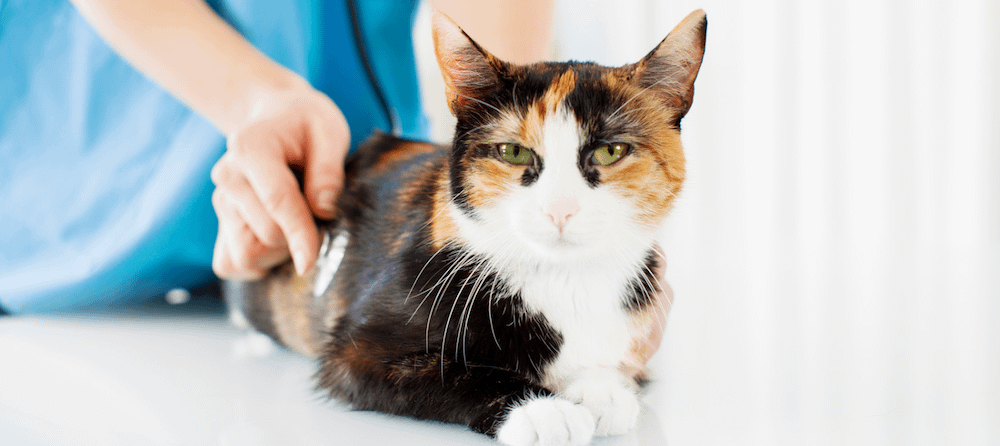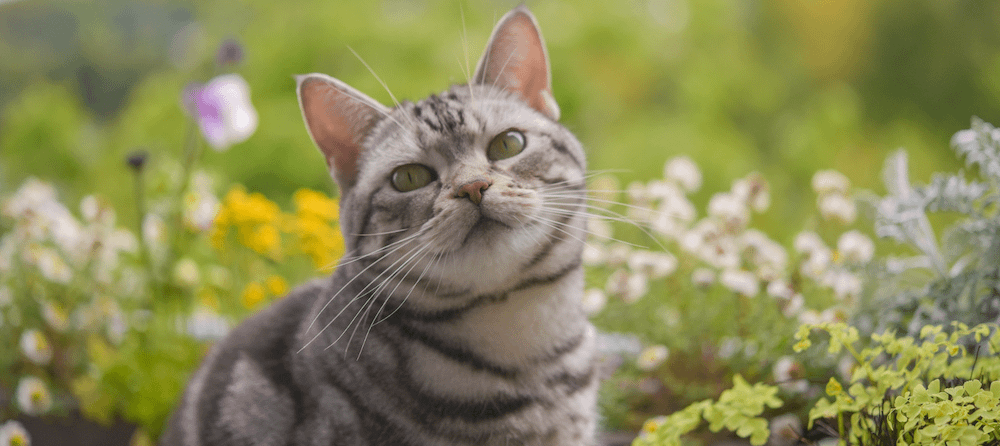Have you noticed a change in your unspayed cat’s physical appearance or behavior lately? If so, you might be asking yourself, “Could my cat be pregnant?” and, “What are the signs of a pregnant cat?”
Sometimes it can be hard to tell if a cat is overweight or if they are pregnant. This is likely something you’ve wondered about if your cat is not fixed and able to access the outdoors, where she might come across an unneutered male cat.
There are symptoms that occur during the gestation period for cats that can key you into there being something different with their bodies. Knowing these signs will help you get a clearer picture of what’s going on with your feline. By the way, intact female cats are called “queens,” which seems pretty fitting to us!
If you’ve ever been concerned about your cat possibly being pregnant, you should always call your veterinarian and set up an appointment. Depending on the expected due date of your cat, your veterinarian may be able to determine if your cat is pregnant and how many kittens she will be a mother to soon.
How long is a cat pregnant?
Signs of pregnancy in cats might not begin showing until a few weeks in. The gestation period for cats is typically between 63 and 67 days, which is roughly 2 months. If you begin noticing changes in your cat’s appearance or behavior, such as weight gain or sleeping more than usual, it could be an indication of cat pregnancy. Pregnancy symptoms in cats are very similar to those in humans in many ways: one of those ways being that pregnancy symptoms can be very vague in the beginning.
Schedule an appointment with your veterinarian as soon as you notice any of these behavioral changes in order to get some confirmation. However, there are more signs and symptoms to look for before bringing your cat in for a vet visit.
What are the physical signs of a pregnant cat?
Your cat’s physical appearance will change as they show signs of pregnancy. The typical things that you might expect, like weight gain and increased sleeping habits, are tell-tale signs, but there are other changes that become apparent as the weeks go by.
Around 3 weeks, the physical changes start to become obvious. It’s at this point that you might begin questioning whether or not your cat is pregnant, how you’ll be as a cat grandparent, or if you should throw your queen a baby shower.
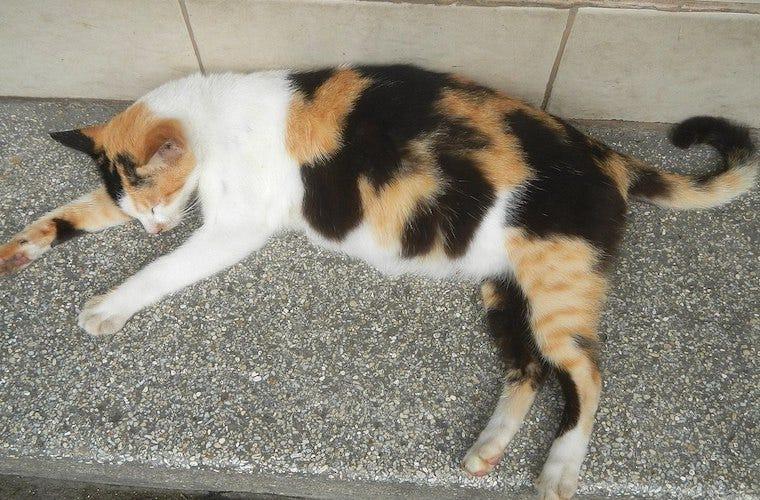
Weight gain
The most commonly noted first symptom of pregnancy in many cats is weight gain. During pregnancy, females will gain 2 to 4 pounds. It is important to keep an eye on your pet’s weight and make a note of any increases. If you notice a quick weight change, that is a good reason to schedule a vet visit, even if you were suspicious that she may be pregnant.
Also commonly, many cats are overweight. Distinguishing an overweight cat from a pregnant cat by sight alone has proven to be much more difficult than many expect. Weight gain in pregnant cats is typically restricted to their stomachs and as the pregnancy progresses, it starts resembling what would be coined as a “pot belly.” If your cat is simply overweight, you will notice that she gains weight in other parts of her body, like her neck, paws, face, and legs.
Change in nipple appearance
If your cat is pregnant, you’ll see pink (or otherwise pigmented) nipples poking out from underneath her fur. You may also notice that as her pregnancy progresses, her nipples may look swollen and rosier than usual. Breeders refer to the color change as a process known as “pinking up.”
If the weight gain doesn’t catch your attention, this “pinking up” can be the first physical sign that will clue you into your cat’s situation. You may even notice some discharge coming from your cat’s nipples, especially as her pregnancy progresses. As long as the discharge is not blood tinged, it is best to leave it and your cat alone as her body is lactating in preparation for feeding her kittens. If the discharge has an odd smell or color or just seems abnormal, schedule an appointment with your vet to check it out and make sure that mama kitty is okay.
Swollen abdomen
Around the halfway point of the gestation period, you’ll notice your cat's belly start to swell or become distended. This swelling is often distinguishable from the aforementioned weight gain and starts at about 5 weeks into the gestation period.
Vomiting
Like human mothers-to-be, your cat can experience what you would call morning sickness. Vomiting can be an early sign of pregnancy, too, usually happening around the 3-week mark. If this happens, check that she’s drinking enough water to stay hydrated. You don’t want her to lose her energy or become sick due to dehydration or lack of fluids.
Vomiting more than 1-2 times a month is always a reason to take your cat to the vet: especially if you’re not aware that she may be expecting. If the vomiting continues and no other symptoms of pregnancy occur, take your cat to the vet as soon as possible. Vomiting could be a sign of other health-related issues; you will want to get that taken care of.
Behavioral signs of a pregnant cat
Physical changes may not always happen overnight, but personality changes are generally easier to spot. You know your cat best, and if she begins to act abnormally, you’ll probably pick up on it. Sometimes it can be easier to notice the changes in her behavior compared to the physical changes.
Heat cycles change
If you have chosen to keep your cat unaltered, it is best to keep a close eye on her heat cycle. You are her first line of defense in the event that she becomes pregnant or has a complication associated with her intact status such as contracting an infection of her uterus called pyometra, false pregnancies, or development of cancerous tumors of her breast or uterine tract.
Kittens as young as 4 months can reach sexual maturity and begin their heat cycles. Normal heat cycles for cats can last anywhere from 3 to 20 days and repeat 2 to 3 times during a typical breeding season (tentatively February to October). During their heat cycles, your female cat will often be more affectionate, groom herself more frequently, meow or yowl much louder than usual, mark her territory often, and possibly lose her appetite. If the heat cycle suddenly stops, your cat is likely pregnant.
If you do not plan to spay your cat as soon as possible, you can benefit from tracking their cycle to avoid any surprises.
Increased appetite
Pregnancy is different for every queen: before your cat begins to eat more than normal, it’s likely that she will experience a decrease in appetite. This might be in response to feelings of nausea while her kittens begin the early stages of their development.
After a few weeks or days of not eating much, you may notice an increase in your cat’s appetite, with her consuming more than she normally would. Reminder: this is because your pregnant cat is eating for more than just herself! There is no reason to ration out or limit your pregnant cat’s food intake as they often regulate themselves well.
As the kittens grow, she’ll need more nutrients to supplement her body. This will ensure that the kittens are born healthy and developed.
Increased sleep patterns
Being pregnant is a lot of work. It takes up energy, nutrients, and energy resources to create healthy kittens; so don’t be surprised if your cat takes more naps. Your cat will spend more time sleeping when she is pregnant to reserve energy. If you notice your cat napping more often throughout the day and she appears otherwise healthy, then it’s possible she is pregnant and just resting up. As always, schedule an appointment with your vet if you’re unsure as to whether her behavioral change is normal or a symptom of a problem.
More affectionate
While your cat might become territorial over her space and toward other animals in the house, she may become more affectionate toward you. Due to hormonal and neurological changes during pregnancy, you may notice your furry friend is seeking your attention more often than usual. She likely trusts you enough to keep her safe and go through the process with you, so be sure to give her all of the attention that she wants.
More reclusive
While increased affection is a common sign early in your cat’s pregnancy, later on you may notice that your cat is more reclusive. In particular, your cat may be more apt to hide or shut herself away in her nesting area the week leading up to labor. She’s preparing for a big moment and knows it, so she may need some space.
Sometimes cats skip this phase and continue to be affectionate and clingy with their humans. You’ll just have to find out!
Nesting behavior
To prepare for the delivery of her litter, the soon-to-be mother cat will look for secluded, quiet places to give birth. This is when you are most likely to notice her becoming more territorial with other animals if they threaten to infringe upon her space. She will begin to do this only a few weeks before she gives birth.
Restlessness
24 to 48 hours before labor, your cat may show signs of restlessness. These include pacing back and forth, acting fidgety, hovering near her nesting area, and generally showing signs of discomfort. This is her way of letting you know that the time is almost here.
What should I do if my cat is pregnant?
Cats generally manage pregnancy with little difficulty, so there isn’t too much you need to do in the weeks or days leading up to birth. It’s best to keep your vet in the loop, since they are the true experts.
Here are a few things you can do to keep your cat healthy and comfortable throughout her pregnancy.
Visit the vet as frequently as recommended
Schedule a visit with your vet as soon as possible. Your vet can perform an ultrasound to detect pregnancy as early as 25–35 days gestation: doing so before 21 days can result in false-negatives. Your vet will also perform a physical exam of your cat, including her abdomen: they will take this opportunity to feel for kittens in your cat’s womb. Fetal heartbeats are detectable around day 25 of a cat’s gestation period.
Vets can also take X-rays when your cat is further along to determine how many kittens she’s carrying. Kittens’ spines and skulls become visible after 42 days in the womb, so abdomen checks and X-rays are most useful after the 42-day mark.
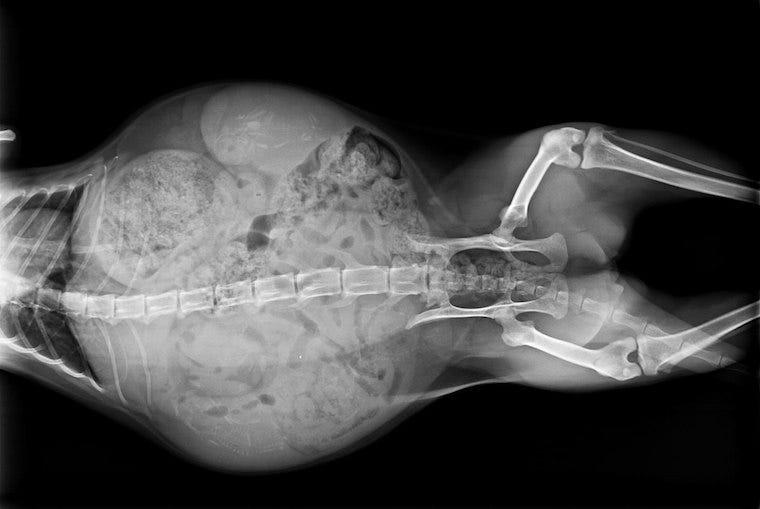
Maintain a healthy diet
Make sure your cat is eating sufficient amounts of food and drinking lots of water. You may want to switch her over to high-quality, highly-digestible food during pregnancy as well.
Some cat foods are specifically formulated for pregnant cats and are designed to help with both the growth and development of the kittens. These foods are excellent when it comes to providing both the mom and her kittens with all of the nutrients that they need.
Provide a quiet place for nesting
As your cat gets closer to giving birth, she’ll start to look for a quiet and soft place to nest. Cat furniture, large cat beds, or even cardboard boxes lined with towels are great options for pregnant cat moms. She’ll always be safe and cozy with the help of a nesting spot where she can rest, destress, and prepare for her big day!
Wondering how many kittens are in a cat's first litter? First-time pregnancy usually results in smaller litters, but in general, your cat could have anywhere between 1 and 9 kittens!
Keep the litter box clean
Keep a clean litter box for your expecting feline. It will help keep her happy and healthy during her pregnancy. Scoop waste out of the litter box daily and change the litter once or twice a month for optimal happiness and health.
A great way to keep your litter box as sanitary as possible for your pregnant cat is to use a self-cleaning litter box like Litter-Robot, in tandem with pet-friendly cleaner spray or cleaner wipes. You won’t have to worry about scooping and cleaning the box constantly, all while ensuring that your pet has a healthy environment to relieve herself.
Ensure a happy and healthy pregnancy
Treat your pregnant cat like the queen she is by taking the necessary steps to provide the best environment for her throughout the gestation period. Pregnant or not, Litter-Robot and the Whisker app are the perfect pairings for cats in all phases of life.
With Litter-Robot, you’ll get notified when the litter box needs your attention. Plus, you will also be able to monitor your cat’s bathroom behaviors right from your phone.
A final note on spaying cats
While the prospect of having a litter of kittens is exciting, it is highly recommended that you spay your cat after she has healed from giving birth. Spaying your cat is not only better for her overall health as mentioned earlier, but it helps curb feline overpopulation as well.
Learn more about why a spayed cat will live longer. (And don’t forget to neuter your male cats, too!)
Sources:
- Clinical Management Of Pregnancy In Cats | NCBI
- Female Reproduction | NCBI
- Nutritional Approach Of Pregnant Queens And Neonate Cats: A Review | Research Gate
- Why You Should Spay/Neuter Your Pet | The Humane Society of the United States
- Breeding and Reproduction of Cats - Cat Owners | Merck Veterinary Manual
- Female Reproduction | PMC
- Pregnancy Determination in Dogs and Cats
Photo by Li Lin on Unsplash

